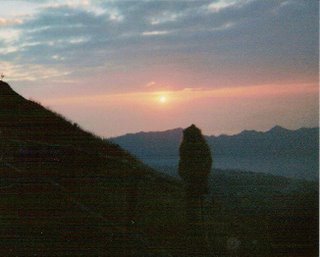L. Riofrio's Blog, page 4
January 30, 2015
BICEP2 Inflation Result Is False
The latest results from the PLANCK satellite will be released next week, and BICEP2 was wrong, wrong about detecting gravitational waves from "inflation". BICEP2 saw galactic dust, but their data was inflated into a "smoking gun" proof if inflation. More about this soon.
Published on January 30, 2015 07:56
October 18, 2014
Planck Units: M = R = t
In response to some evocative comments, here is an old post from October 1, 2007! The Planck units point to a quantum nature of space and time. Though this post is celebrating its seventh birthday, this marvelously simple equation is still not common knowledge.

"I perceive the Universe as a single equation, and it is so simple..."
--LT Barclay in STAR TREK TNG: "The Nth Degree"
Posting was light the past week, but some work got done. Today we'll return to the subject of Planck units. Max Planck started as a conservative physicist studying atomic spectra. The ultraviolet catastrophe led him to a "act of desperation," the quantum value h. Planck was also instrumental in getting a patent clerk's first papers published in 1905. If not for Planck, the world might have taken decades to hear of Einstein.
Planck noted that combinations of h, c and G led to this "universal" system of units. At the time he had no way of knowing whether h or c were constant. Some science types get lazy and say that h = c = G =1. They are not equal, or they could be used interchangeably.
We'll use Planck's units to express something more useful. A basic principle states that scale R of the Universe is its age, a timelike separation from the "Big Bang." R and t are related by factor c, the "speed of light."
R = ct
This equation (1) caused the Big Bang. As t increases, the Universe expands.
R/l_pl = ct/l_pl
Now l_pl = ct_pl, so:
R/l_pl = t/t_pl
Expressed in Planck units, equation (1) becomes:
R = t
We can simply express that size of the Universe is related to its age. This may appear more palatable to those used to thinking that c is constant.
The Universe can't expand at the same rate forever, for Mass and Gravity slow it down. We do some calculations, and c is further related to t by:
GM = tc^3
Expressing equation (2) in Planck units:
M/t = c^3/G = m_pl/t_pl
M/m_pl = t/t_pl
The Planckian expression of GM=tc^3 was also noted by bloggers Thomas Dent and Lubos Motl. Using Planck units can be misleading, because they are not all constant. Now we can state both equations (1) and (2) in a single line:
M = R = t
Repeat: This must be the simplest equation ever! It relates everything you want to know about the Universe but were afraid to ask: Mass M, size R, age t, expansion rate and how it slows with time. This shows just how powerful mathematics can be. According to STAR TREK, one line may explain an entire Universe.
Planck is not the only one who started as a conservative physicist. When these equations are worked out, the appeal is hard to deny even for the conservative. Arriving at a simple solution makes all the challenges of science worthwhile. The simplicity may someday be noticed by physicists, possibly in the 24th century. This may be an equation far ahead of its time.

"I perceive the Universe as a single equation, and it is so simple..."
--LT Barclay in STAR TREK TNG: "The Nth Degree"
Posting was light the past week, but some work got done. Today we'll return to the subject of Planck units. Max Planck started as a conservative physicist studying atomic spectra. The ultraviolet catastrophe led him to a "act of desperation," the quantum value h. Planck was also instrumental in getting a patent clerk's first papers published in 1905. If not for Planck, the world might have taken decades to hear of Einstein.
Planck noted that combinations of h, c and G led to this "universal" system of units. At the time he had no way of knowing whether h or c were constant. Some science types get lazy and say that h = c = G =1. They are not equal, or they could be used interchangeably.
We'll use Planck's units to express something more useful. A basic principle states that scale R of the Universe is its age, a timelike separation from the "Big Bang." R and t are related by factor c, the "speed of light."
R = ct
This equation (1) caused the Big Bang. As t increases, the Universe expands.
R/l_pl = ct/l_pl
Now l_pl = ct_pl, so:
R/l_pl = t/t_pl
Expressed in Planck units, equation (1) becomes:
R = t
We can simply express that size of the Universe is related to its age. This may appear more palatable to those used to thinking that c is constant.
The Universe can't expand at the same rate forever, for Mass and Gravity slow it down. We do some calculations, and c is further related to t by:
GM = tc^3
Expressing equation (2) in Planck units:
M/t = c^3/G = m_pl/t_pl
M/m_pl = t/t_pl
The Planckian expression of GM=tc^3 was also noted by bloggers Thomas Dent and Lubos Motl. Using Planck units can be misleading, because they are not all constant. Now we can state both equations (1) and (2) in a single line:
M = R = t
Repeat: This must be the simplest equation ever! It relates everything you want to know about the Universe but were afraid to ask: Mass M, size R, age t, expansion rate and how it slows with time. This shows just how powerful mathematics can be. According to STAR TREK, one line may explain an entire Universe.
Planck is not the only one who started as a conservative physicist. When these equations are worked out, the appeal is hard to deny even for the conservative. Arriving at a simple solution makes all the challenges of science worthwhile. The simplicity may someday be noticed by physicists, possibly in the 24th century. This may be an equation far ahead of its time.
Published on October 18, 2014 10:04
October 16, 2014
Book Tour Continues
THE SPEED OF LIGHT book tour started here in Johnson Space Center, has been to the North Houston Astronomy Club and Texas A&M University in College Station. Next stop is the Brazosport Astronomy Club meeting at Center for Arts and Sciences, 400 College Blvd in Clute, Texas on Tuesday October 21. We will start at 7:00 PM with a presentation on the Rosetta mission. Maybe you an make it!
Published on October 16, 2014 12:49
September 26, 2014
Here Be Dragons Pt V
In 2005 our Cassini spacecraft made some amazing discoveries about Saturn and her moons. The moon Enceladus has a volcanic "hot spot" centred on its South Pole. The pole, which should be the coldest region on the moon, is the hottest! This spot emits an enormous plume of vapour which maintains Saturn's E Ring. Old theories of radioactive decay or tidal stress can not explain this hot spot.
Enceladus' core and behaviour can be modelled with a central singularity of 10^12 kg. This mass is typical for a primordial singularity. This object consumes only 2.8 kg per year and generates 10^9 watts of radiation. Water and other molecules near this centre are heated to a plasma. Electrons are stripped from atoms, and the resulting ions are drawn into circular orbits. The resulting current generates a magnetic field with the "positive" pole in the South.
Electrons and positively charged ions spiral along magnetic field lines to form bipolar jets, the classic sign of a singularity. The Northern jet is composed of electrons which are absorbed by the moon's interior. More energetic ions of the Southern jet penetrate these layers to warm the South Pole. Escaping ions spiral into space, exactly as observed by Cassini.
Unless Saturn's Rings are replenished, they would decay within 100 million years. Then we would face the anthropic question of why they exist in the right time for humans to view them. Thanks to the Cassini spacecraft, we have witnessed the E Ring being resuppllied from a moon. This observation suggests that similiar processes maintain the rings indefinitely.
Saturn and her Rings have long been objects of wonder and mystery. The processes that build moons and planets have been going on for billions of years. Humans have yet to understand what is before their eyes and beneath their feet. There is more to this solar system than meets the eye.
Enceladus' core and behaviour can be modelled with a central singularity of 10^12 kg. This mass is typical for a primordial singularity. This object consumes only 2.8 kg per year and generates 10^9 watts of radiation. Water and other molecules near this centre are heated to a plasma. Electrons are stripped from atoms, and the resulting ions are drawn into circular orbits. The resulting current generates a magnetic field with the "positive" pole in the South.
Electrons and positively charged ions spiral along magnetic field lines to form bipolar jets, the classic sign of a singularity. The Northern jet is composed of electrons which are absorbed by the moon's interior. More energetic ions of the Southern jet penetrate these layers to warm the South Pole. Escaping ions spiral into space, exactly as observed by Cassini.
Unless Saturn's Rings are replenished, they would decay within 100 million years. Then we would face the anthropic question of why they exist in the right time for humans to view them. Thanks to the Cassini spacecraft, we have witnessed the E Ring being resuppllied from a moon. This observation suggests that similiar processes maintain the rings indefinitely.
Saturn and her Rings have long been objects of wonder and mystery. The processes that build moons and planets have been going on for billions of years. Humans have yet to understand what is before their eyes and beneath their feet. There is more to this solar system than meets the eye.
Published on September 26, 2014 13:37
September 25, 2014
Here Be Dragons Part IV

Gunung Batur as we descended in the light of day.
There have been several mysteries about the planet we live on. What causes Earth's internal heat, which has persisted for billions of years? What powers the "dynamo" of planetary magnetic fields? How could the planets coalesce from an orbiting disk of gas? If particles collide at orbital velocities they will not stick together unless they have the mass of mountains. The answer lies not in geology, but in cosmology.
The Big Bang created billions upon billions of Black Holes. They formed from quantum fluctuations grown large by expansion of the Universe. They are the largest component of mass in the Universe, surrounding the galaxies with invisible haloes. Our own solar system contains hundreds of these tiny holes, and we have been ignorant of their existence.
When the solar system was but a disk of gas, a number of singularities started orbiting in the disk. One of these objects was smaller than a proton, yet weighed as much as a mountain. Larger particles were attracted and stuck to it. The singularity was far too tiny to eat everything up, but the small amount that was swallowed made the rest grow red hot. Eventually a ball of rock formed with a hot centre. This was the birth of a planet.
The singularity in Earth's core has the diameter of a grain of sand, and the mass of a moon. It has been giving off radiation for billions of years. The heat generated causes volcanoes to erupt, creates the continents, and forms hydrocarbons in Earth's interior. Our life and this planet would not exist without it. Even the petrol that fills your tank may be the byproduct of a small Black Hole!
This singularity spins independently within Earth's core. By dragging part of the iron core along, it spins the "dynamo" generating a magnetic field. That is why Earth's magnetic poles are not aligned with the geographic poles, and why this field sometimes changes direction. Venus has no magnetic field because its core does not spin. Mercury has a magnetic field and is here predicted to have vulcanism, which our MESSENGER spacecraft will discover in 2011.
These are truly exciting times! By climbing into the dragon's fiery mouth, we can understand the very origin of the world! A Black Hole can exist in the last place anyone would look for one, right beneath our noses! TOMORROW we will see another example supporting this theory.
Published on September 25, 2014 13:35
September 24, 2014
Here Be Dragons Pt III

Indonesia's Mount Merapi erupted on this day, forcing thousands to flee their homes. On May 27 an earthquake in Java killed 5,800 people. The December 26, 2004 earthquake and tsunami killed over 200,000. Who says that fire-breathing monsters don't exist? Earth's violent interior is a subject of urgent study.
We woke before 0200 to climb Gunung Batur at night. This active volcano is 1717 m above sea level, and had its last major eruption in 1963. A 1917 eruption killed thousands and destroyed 60,000 homes. The outer crater is nearly 14 km across, big enough to contain a lake and several villages. Guided by our torches, we felt our way through darkness. At the summit, live steam issued from cracks in the Earth. Right on time, the monkeys joined us to watch the sunrise.
The Sun and volcano may be linked by origin. It has long been a puzzle how the stars collapsed and ignited from the tenuous interstellar gas. The heat of Earth's core, which causes volcanoes and earthquakes yet is critical to life, has also been a mystery. The answers may be related to Hawking radiation.
TOMORROW we look back on the volcano in the light of day, and relate cosmology to the fire beneath us.
Published on September 24, 2014 13:33
September 23, 2014
Here Be Dragons Pt II

"The survival of the human race depends on its ability to find new homes elsewhere in the universe because there's an increasing risk that a disaster will destroy the Earth, world-renowned scientist Stephen Hawking said Tuesday."
Hawking's discovery that Black Holes give off radiation has the greatest potential affect on Earth. They convert mass into energy far more efficiently than nuclear fusion. He deduced that mathematically as a young postdoc. At the time, his colleagues thought it was rubbish. You go, Dr. Hawking!
This is the temple of Uluwatu in Bali, situated on a blade of rock jutting hundreds of metres over the ocean. The temple's true inhabitants are the monkeys, to whom we are but guests. I saw one little guy snatch the glasses off a tourist's face, then happily hang on to them while humans tried comically to make him give up. Finally the monkey threw the glasses off the railing, a 250-m drop!
Yesterday we saw a baby dragon. Tomorrow the monkeys will accompany us to the mouth of a real fire-breathing monster. There we may see evidence of Hawking radiation in action.
Published on September 23, 2014 13:31
September 22, 2014
Inflation Crumbles to Dust
Like a vampire that refuses to die, the hypothesis of "cosmic inflation" has been sucking the life out of science. A new paper from the PLANCK spacecraft conclusively finds that the BICEP2 claim of gravitational waves from inflation was due to cosmic dust. More about this soon. Like Dracula after a stake has been driven into his dark heart, inflation crumbles to dust. GM=tc^3, anybody can figure it out.
Published on September 22, 2014 15:09
Here Be Dragons

Yesterday's photo was taken atop the pyramid at Chichen Itza, Yucatan. 1000 years ago, the Maya believed that Space and Time were the same phenomenon. How right they were!
"Here Be Dragons" was written on old maps indicating the unknown and dangerous. This photo was taken in Bali and this is a DRAGON. The world we read about in fairy tales really does exist! There are dragons and princesses, heroes and villains, good and evil. All we need do is be brave and look for them.
I was invited to Bali for the International Astronomical Union (IAU) Meeting. Scientists from all over the world met and shared some fascinating research. Dr. John Huchra (Vice-Provost of Research at Harvard) gave a very good review: "A delightful talk by Louise Riofrio on how a non-standard cosmology with a varying speed-of-light might reproduce the high-redshift supernova Hubble diagram." Thank you, Dr. Huchra!
I've been honoured to contribute a solution to the so-called "accelerating universe" problem. The answer is so simple that a child could understand it, yet matches the data more precisely than any other idea. The Maya were on to something! Tomorrow's post will have more from Bali.
Published on September 22, 2014 13:29
September 18, 2014
Chichen Itza
 Here is the first photo published on this blog in '006. This is the top of the pyramid in Chichen Itza, Yucatan. Human figure added for scale. We have come a long way since then, but time has not eroded the enthusiasm. More photos to come!
Here is the first photo published on this blog in '006. This is the top of the pyramid in Chichen Itza, Yucatan. Human figure added for scale. We have come a long way since then, but time has not eroded the enthusiasm. More photos to come!
Published on September 18, 2014 13:34



